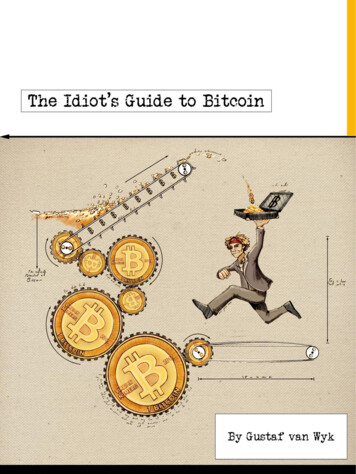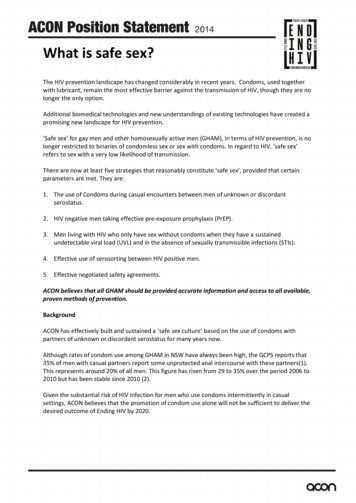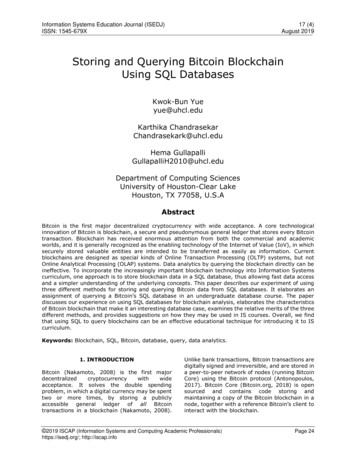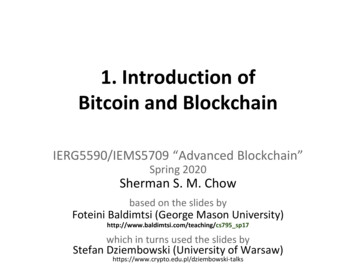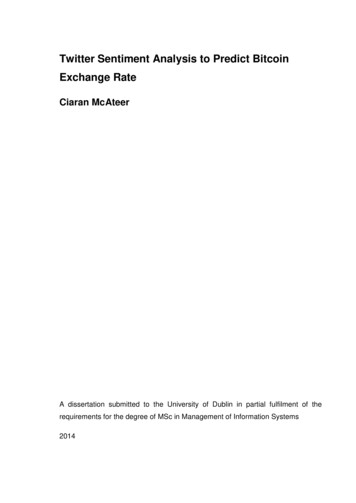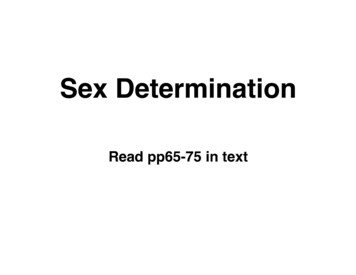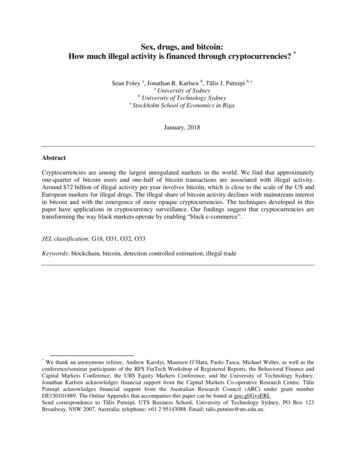
Transcription
Sex, drugs, and bitcoin:How much illegal activity is financed through cryptocurrencies? *Sean Foley a, Jonathan R. Karlsen b, Tālis J. Putniņš b, caUniversity of SydneybUniversity of Technology SydneycStockholm School of Economics in RigaJanuary, 2018AbstractCryptocurrencies are among the largest unregulated markets in the world. We find that approximatelyone-quarter of bitcoin users and one-half of bitcoin transactions are associated with illegal activity.Around 72 billion of illegal activity per year involves bitcoin, which is close to the scale of the US andEuropean markets for illegal drugs. The illegal share of bitcoin activity declines with mainstream interestin bitcoin and with the emergence of more opaque cryptocurrencies. The techniques developed in thispaper have applications in cryptocurrency surveillance. Our findings suggest that cryptocurrencies aretransforming the way black markets operate by enabling “black e-commerce”.JEL classification: G18, O31, O32, O33Keywords: blockchain, bitcoin, detection controlled estimation, illegal trade*We thank an anonymous referee, Andrew Karolyi, Maureen O’Hara, Paolo Tasca, Michael Weber, as well as theconference/seminar participants of the RFS FinTech Workshop of Registered Reports, the Behavioral Finance andCapital Markets Conference, the UBS Equity Markets Conference, and the University of Technology Sydney.Jonathan Karlsen acknowledges financial support from the Capital Markets Co-operative Research Centre. TālisPutniņš acknowledges financial support from the Australian Research Council (ARC) under grant numberDE150101889. The Online Appendix that accompanies this paper can be found at goo.gl/GvsERLSend correspondence to Tālis Putniņš, UTS Business School, University of Technology Sydney, PO Box 123Broadway, NSW 2007, Australia; telephone: 61 2 95143088. Email: talis.putnins@uts.edu.au.
1. IntroductionCryptocurrencies have grown rapidly in price, popularity, and mainstream adoption. The totalmarket capitalization of bitcoin alone exceeds 250 billion as at January 2018, with a further 400 billionin over 1,000 other cryptocurrencies. The numerous online cryptocurrency exchanges and markets havedaily dollar volume of around 50 billion.2 Over 170 “cryptofunds” have emerged (hedge funds thatinvest solely in cryptocurrencies), attracting around 2.3 billion in assets under management.3 Recently,bitcoin futures have commenced trading on the CME and CBOE, catering to institutional demand fortrading and hedging bitcoin.4 What was once a fringe asset is quickly maturing.The rapid growth in cryptocurrencies and the anonymity that they provide users has createdconsiderable regulatory challenges. An application for a 100 million cryptocurrency Exchange TradedFund (ETF) was rejected by the US SEC in March 2017 (and again in 2018) amid concerns including thelack of regulation. China has banned residents from trading cryptocurrencies and made initial coinofferings (ICOs) illegal. Central bank heads have publically expressed concerns about cryptocurrencies.While cryptocurrencies have many potential benefits including faster and more efficient, regulatoryconcerns center around their use in illegal trade (drugs, hacks and thefts, illegal pornography, evenmurder-for-hire), potential to fund terrorism, launder money, and avoid capital controls. There is littledoubt that by providing a digital and anonymous payment mechanism, cryptocurrencies such as bitcoinhave facilitated the growth of “darknet” online marketplaces in which illegal goods and services aretraded. The recent FBI seizure of over 4 million of bitcoin from one such marketplace, the “Silk Road”,provides some idea of the scale of the problem faced by regulators.This paper seeks to quantify and characterize the illegal trade facilitated by bitcoin. In doing so,we hope to better understand the nature and scale of the “problem” facing this nascent technology. Wedevelop methods for identifying illegal activity in bitcoin. These methods can also be used in analyzingmany other blockchains.Several recent seizures of bitcoin by law enforcement agencies (including the US FBI’s seizure ofthe “Silk Road” marketplace), combined with the public nature of the blockchain, provide us with aunique laboratory in which to analyze the illegal ecosystem that has evolved in the bitcoin network.Although individual identities are masked by the pseudo-anonymity of a 26-35 character alpha-numericaddress, the public nature of the blockchain allows us to link bitcoin transactions to individual “users”(market participants) and then further identify the users that had bitcoin seized by authorities. Bitcoin2SEC Release No. 34-79103, March 10, 2017; and https://coinmarketcap.comSource: financial research firm Autonomous Next and cnbc.com.4Bitcoin futures commenced trading on the CME (Chicago Mercantile Exchange) on December 18, 2017 and on theChicago Board Options Exchange (CBOE) on December 10, 2017. A bitcoin futures contract on CBOE is for onebitcoin, whereas on CBOE it is five bitcoins. At a price of approximately 20,000 per bitcoin at the time the CMEbitcoin futures launched, one CME bitcoin futures contract has a notional value of around 100,000.31
seizures (combined with a few other sources) provide us with a sample of users known to be involved inillegal activity. This is the starting point for our analysis, from which we apply two different empiricalapproaches to go from the sample to the estimated population of illegal activity.Our first approach exploits the trade networks of users known to be involved in illegal activity(“illegal users”). We use the bitcoin blockchain to reconstruct the complete network of transactionsbetween market participants. We then applying a type of network cluster analysis to identify two distinctcommunities in the data—the legal and illegal communities. Our second approach exploits certaincharacteristics that distinguish between legal and illegal bitcoin users, applying detection controlledestimation models (simultaneous equation models with latent variables). For example, we measure theextent to which individual bitcoin users take actions to conceal their identity and trading records, which isa predictor of involvement in illegal activity.We find that illegal activity accounts for a substantial proportion of the users and trading activityin bitcoin. For example, approximately one-quarter of all users (25%) and close to one-half of bitcointransactions (44%) are associated with illegal activity. Furthermore, approximately one-fifth (20%) of thetotal dollar value of transactions and approximately one-half of bitcoin holdings (51%) through time areassociated with illegal activity. Our estimates suggest that in the most recent part of our sample (April2017), there are an estimated 24 million bitcoin market participants that use bitcoin primarily for illegalpurposes. These users annually conduct around 36 million transactions, with a value of around 72billion, and collectively hold around 8 billion worth of bitcoin.To give these numbers some context, a report to the US White House Office of National DrugControl Policy estimates that drug users in the United States in 2010 spend in the order of 100 billionannually on illicit drugs.5 Using different methods, the size of the European market for illegal drugs isestimated to be at least 24 billion per year.6 While comparisons between such estimates and ours areimprecise for a number of reasons (and the illegal activity captured by our estimates is broader than justillegal drugs), they do provide a sense that the scale of the illegal activity involving bitcoin is not onlymeaningful as a proportion of bitcoin activity, but also in absolute dollar terms.The use of bitcoin in illegal trade has interesting time-series patterns. In recent years (since 2015),the proportion of bitcoin activity associated with illegal trade has declined. We attribute this trend to twomain factors. The first is an increase in mainstream and speculative interest in bitcoin. For example, wefind that the proportion of illegal activity in bitcoin is inversely related to the Google search intensity for5The report, prepared by the RAND Corporation, estimates the user of cocaine, crack, heroin, marijuana, andmethamphetamine, and is available at (www.rand.org/t/RR534). A significant share of the illegal activity involvingbitcoin is likely associated with buying/selling illegal drugs online (e.g., Soska and Christin, 2015), which is whatmotivates the comparison with the size of the market for illegal drugs.6The estimate is from the European Monitoring Centre for Drugs and Drug Addiction / Europol “EU Drug MarketsReport” for the year 2013. (http://www.emcdda.europa.eu/attachements.cfm/att 194336 EN TD3112366ENC.pdf)2
the keyword “bitcoin”. Furthermore, while the proportion of illegal bitcoin activity has declined, theabsolute amount of such activity has continued to increase, indicating that the declining proportion is dueto rapid growth in legal bitcoin use. The second factor is the emergence of alternative cryptocurrenciesthat are more opaque and better at concealing a user’s activity (e.g., Dash, Monero, and ZCash). We findthat the emergence of such alternative cryptocurrencies is also associated with a decrease in theproportion of illegal activity in bitcoin. Despite these two factors affecting the use of bitcoin in illegalactivity, as well as numerous darknet marketplace seizures by law enforcement agencies, the amount ofillegal activity involving bitcoin at the end of our sample in April 2017 remains close to its all-time high.Bitcoin users that are involved in illegal activity differ from other users in several characteristics.Differences in transactional characteristics are generally consistent with the notion that while illegal userspredominantly (or solely) use bitcoin as a payment system to facilitate trade in illegal goods/services,some legal users treat bitcoin as an investment or speculative asset. Specifically, illegal users tend totransact more, but in smaller transactions. They are also more likely to repeatedly transact with a givencounterparty. Despite transacting more, illegal users tend to hold less bitcoin, consistent with them facingrisks of having bitcoin holdings seized by authorities.We find several other robust predictors of involvement in illegal activity. A user is more likely tobe involved in illegal activity if they trade when there are many darknet marketplaces in operation, fewshadow coins in existence, little bitcoin hype or mainstream interest, and immediately following darknetmarketplaces seizures or scams. A user is also more likely to be involved in illegal activity if they use“tumbling” and/or “wash trades”—trading techniques that help conceal one’s activity.The network of bitcoin transactions between illegal users is three to four times denser, with usersmuch more connected with one another through transactions. The higher density is consistent with illegalusers transacting more and using bitcoin primarily as a payment system in buying/selling goods.It is important to consider the differences between cryptocurrencies and cash. After all, cash isalso largely anonymous (traceable only through serial numbers) and has therefore traditionally played animportant role in facilitating crime and illegal trade (e.g., Rogoff, 2016). The key difference is thatcryptocurrencies (similar to PayPal and credit cards) enable digital transactions and thus e-commerce.Arguably, the ability to make digital payments revolutionized retail and wholesale trade. Online shoppingsubstantially impacted the structure of retailing, consumption patterns, choice and hence welfare,marketing, competition, and ultimately supply and demand. Until cryptocurrencies, such impacts werelargely limited to legal goods and services due to the traceability of digital payments. Cryptocurrencieshave changed this, by combining the anonymity of cash with digitization, which enables efficientanonymous online and cross-border commerce. Cryptocurrencies therefore have the potential to cause animportant structural shift in how the black market operates.3
While the emergence of illegal darknet marketplaces illustrates that this shift has commenced, itis not obvious to what extent the black market will adopt the opportunities for e-commerce and digitalpayments via cryptocurrencies—this is an important empirical question. Our findings illustrate thedynamics of this adoption process and suggest that eight years after the introduction of the firstcryptocurrency, the black market has indeed adopted this form of electronic payment on a meaningfulscale. Thus, our results suggest that cryptocurrencies are having a material impact on the way the blackmarket for illegal goods and services operates.Our findings have a number of further implications, which we discuss in Section 6. Blockchaintechnology and the systems/protocols that can be implemented on a blockchain have the potential forrevolutionizing numerous industries. In shedding light on the dark side of cryptocurrencies, we hope thisresearch will reduce some of the regulatory uncertainty about the negative consequences and risks of thisinnovation, facilitating more informed policy decisions that assess both the costs and benefits. In turn, wehope this contributes to these technologies reaching their potential. Second, our paper contributes tounderstanding the intrinsic value of bitcoin, highlighting that a significant component of its value as apayment system derives from its use in facilitating illegal trade. This has ethical implications for bitcoinas an investment, as well as valuation implications. Third, our paper moves the literature closer tounderstanding the welfare consequences of the growth in illegal online trade. A crucial piece of thispuzzle is understanding the extent to which illegal online trade simply reflects a migration of activity thatwould have otherwise occurred on the street, versus the alternative that by making illegal goods moreaccessible, convenient to buy, and less risky to buy due to anonymity, “black e-commerce” could lead togrowth in the aggregate black market. Our estimates contribute to understanding this issue, but furtherresearch is required to relate these estimates to trends in the offline black market to further ourunderstanding of the welfare consequences.This paper also makes a methodological contribution. The techniques developed in this paper canbe used in cryptocurrency surveillance in a number of ways, including monitoring trends in illegalactivity, its response to regulatory interventions, and how its characteristics change through time. Themethods can also be used to identify key bitcoin users (e.g., “hubs” in the illegal trade network) which,when combined with other sources of information, can be linked to specific individuals. The techniques inthis paper can also be used to study other types of activity in bitcoin or other cryptocurrencies /blockchains.Our paper contributes to a few areas of recent literature, which we discuss in more detail inSection 6. We add to the literature on the economics of cryptocurrencies and applications of blockchaintechnology to securities markets by showing that one of the major uses of cryptocurrencies as a payment4
system is in settings where anonymity is valued (e.g., illegal trade).7 Our paper also contributes to thecomputer science literature that analyzes the degree of anonymity in bitcoin by developing algorithms thatidentify entities/users/activities in bitcoin’s blockchain.8 We exploit algorithms from this literature toidentify individual users in the data, and we add new methods to the literature that go beyond observingindividuals, to identification of communities and estimation of populations of users. Finally, our paper isalso related to studies of darknet marketplaces and the online drug trade, including papers from computerscience and drug policy.9 We contribute to this literature by quantifying the amount of illegal activity thatinvolves bitcoin, rather than studying a single market (e.g., Silk Road) or indirect lower-bound measuresof darknet activity such as the feedback left by buyers. Empirically, we confirm that the estimatedpopulation of illegal activity is several times larger than what can be “observed” through studyingobservable darknet marketplaces and their customers.The next section provides institutional details about bitcoin and the blockchain, darknetmarketplaces in which illegal goods and services are bought/sold using bitcoin, and law enforcementefforts to monitor and disrupt illegal online activity. Section 3 describes the blockchain data used in thispaper. Section 4 explains three approaches that we use to construct a sample of illegal activity andcharacterizes that sample. The sample forms the input to our empirical methods in Section 5 that quantifythe total amount of illegal activity, its trends, and its characteristics. A discussion of the implications ofthe results and how they relate to existing studies is in Section 6, while Section 7 concludes.2. Institutional details2.1. The structure of the bitcoin blockchainBitcoin is an international currency, not associated with any country or central bank, backed onlyby its limited total supply and the willingness of bitcoin users to recognize its value.10 Bitcoins are“mined” (created) by solving cryptographic puzzles that deterministically increase in difficulty and oncesolved can be easily verified. Each solution results in a new “block” and provides the miner with the“block reward” (currently 12.5 bitcoins), which incentivizes the miner. The difficulty of the cryptographicpuzzles is adjusted after every 2,016 blocks (approximately 14 days) by an amount that ensures theaverage time between blocks remains ten minutes.7See: Malinova and Park, 2016; Khapko and Zoican, 2016; Yermack, 2017; Huberman et al., 2017; Easley et al.,2017.8See: Meiklejohn et al., 2013; Ron and Shamir, 2013; Androulaki et al., 2013; Tasca et al., 2016.9See: Soska and Christin, 2015; Barratt et al., 2016a; Aldridge and Décary-Hétu, 2016; Van Buskirk et al., 2016.10As of January 2017, over 16 million bitcoins had been mined out of a maximum of 21 million. This maximumlimit is built into the protocol (Nakamoto, 2008).5
Each block, as well as expanding the supply of bitcoin, confirms a collection of recenttransactions (transactions since the last block). Each block also contains a reference to the last block,thereby forming a “chain”, giving rise to the term “blockchain”. The blockchain thus forms a completeand sequential record of all transactions and is publically available to any participant in the network.Bitcoins are divisible to the “Satoshi”, being one hundred millionth of one bitcoin (currentlyworth less than two hundredths of a cent). Each bitcoin holding (or parcel) is identified by an address,analogous to the serial number of a banknote. Unlike banknotes, bitcoin does not have to be held in roundunits (e.g., 5, 10, 50). Unless a holding of bitcoin with a given address is exactly spent in a transaction,the “change” from the transaction is returned to a new address forming a new parcel of bitcoin.A bitcoin “user” (a participant in the network) stores the addresses associated with each parcel ofbitcoin that they own in a “wallet”. Similar to a conventional cash wallet, a bitcoin wallet balance is thesum of the balances of all the addresses inside the wallet. While individual bitcoin addresses are designedto be anonymous, it is possible to link addresses belonging to the same wallet when more than oneaddress is used to make a purchase.2.2. Darknet marketplaces and their microstructureThe “darknet” is a network like the internet, but that can only be accessed through particularcommunications protocols that provide greater anonymity than the internet. The darknet contains onlinemarketplaces, much like EBay, but with anonymous communications, which also makes thesemarketplaces less accessible than online stores on the internet. Darknet marketplaces are particularlypopular for trading illegal goods and services because the identities of buyers and sellers are concealed.The darknet is estimated to contain approximately 30,000 domains (Lewman, 2016).To access a darknet marketplace, a user is generally required to establish an account (usually free)at the marketplace in order to browse vendor products (Martin, 2014a; Van Slobbe, 2016). Similar to theway PayPal propelled EBay, the secure, decentralized, and anonymous nature of cryptocurrencies hasplayed an important role in the success of darknet marketplaces. While bitcoin is the most widespreadcryptocurrency used in such marketplaces, other currencies have occasionally been adopted, either due totheir popularity (such as Ethereum) or improved anonymity (such as Monero). Despite the availability ofalternate currencies on some marketplaces, the vast majority of transactions on the darknet are stillundertaken in bitcoin.11A user that wants to buy goods or services on a darknet marketplace must first acquirecryptocurrency (typically from an online exchange or broker) and then deposit this in an address11A recent estimate from a darknet marketplace operator identified bitcoin as accounting for 98% of drug-dealers-cryptocurrency-choice-fire/.6
belonging to the darknet marketplace (often termed a “hot wallet”). These funds are held in “escrow” bythe marketplace. Vendor prices on darknet markets are often quoted inclusive of a marketplace fee. Theescrow system also assists marketplace administrators in mediating disputes between buyers and sellersand minimizing scams in which money is collected without the intention of ever shipping any goods(Aldridge and Décary-Hétu, 2014; Christin, 2013). Funds are released when the vendor indicates thegoods have been sent. In some marketplaces, the funds are held until the buyer indicates that the goodshave been received. The escrow function of the darknet marketplaces sometimes leads to “exit scams”,whereby a marketplace ceases operations but does not return bitcoin held in escrow. Many such scamshave been perpetrated by marketplaces in the last five years, including Sheep Marketplace (2013), PirateMarket (2014), Evolution (2015), and Nucleus (2016).The evolution of dark marketplaces allows sellers of illegal goods and services to reach globalaudiences (Van Buskirk et al., 2016). This internationalization of illegal trade necessitates more complexmethods of communications and logistics to avoid detection. To this end, buyers placing an order with anonline seller typically communicate using PGP (Pretty Good Privacy) encryption, which encodes anddecodes messages using a pair of public and private keys (Cox, 2016). On some (typically more recent)marketplaces, this functionality is built into the site. Logistically, items are typically delivered by mailand the process by which this occurs has been widely documented (Christin, 2013; Van Hout andBingham, 2013; Lavorgna, 2016; Van Slobbe, 2016). Many methods are used to minimize the chance ofsuch deliveries being intercepted by law enforcement, including professional logos, vacuum sealed bags,posting small quantities of product, and including a (fake) return address (Christin, 2013; Basu, 2014;Tzanetakis et al., 2016). Customers are advised by marketplaces to avoid using their real name or addressto minimize the risk of being caught by law enforcement agencies (Martin, 2014b).After receiving their goods, buyers are encouraged to leave feedback about the seller,commenting on the arrival (or otherwise) of the goods, their quality, and overall service (Van Slobbe,2016). Such feedback is paramount for developing a reputation in a marketplace that is primarily based ontrust between participants, with few ramifications for “scamming” purchasers (Aldridge and Décary-Hétu,2014; Tzanetakis et al., 2016).To get a sense of how a buyer navigates a darknet marketplace, Figure 1 provides screenshotsfrom one of the first darknet marketplaces, “Silk Road”. Panel A provides an example of the “Drugs”page illustrating that a wide variety of illegal drugs, weapons, and forgeries can be purchased usingbitcoin. Panel B provides an example of information about individual items and sellers. Clicking on theappropriate headings, one can obtain further information about the items (detailed description,insurance/refund policies, available postage methods and locations, security and encryption, and so on)and about the seller (their rating from buyers, detailed feedback from buyers, history of sales, and so on).7
Panel C shows the interface for depositing bitcoin to Silk Road’s escrow account, how to transfer bitcoinsto a given seller, and how to withdraw bitcoins from escrow. Figure 1 By providing an anonymous, digital method of payment, bitcoin did for darknet marketplaceswhat PayPal did for EBay—provide a reliable, scalable, and convenient payment mechanism. What wasalso required was an anonymous way of hosting and accessing those illegal marketplaces. This issue issolved through the use of The Onion Router (TOR), originally developed by the US Navy. By routing themessage through several nodes in the TOR network, TOR obfuscates the path (and hence the IP address)of a message sent between two clients.The combination of TOR for covert communications and bitcoin for covert payments has led tothe proliferation of darknet marketplaces. The most well-known marketplace was the “Silk Road” startedin 2011. Since its shutdown by the FBI in 2013, numerous other marketplaces have sprung up (see TableA2 in Appendix A for a list). Despite frequent shutdowns, seizures and scams, measures of darknetmarketplace activity indicate steady growth in the number of market participants and products (Matthewset al., 2017). For example, one of the largest marketplaces in 2017, “AlphaBay”, had over 350,000 itemsavailable for sale in categories such as drugs, weapons, malware, and illegal pornography.2.3. Surveillance and cryptocurrency seizures from darknet marketplacesCryptocurrencies have proven effective not only in facilitating illegal trade, but also in thedetection of illegal activity due to the public nature of the blockchain. Even though bitcoin has been usedextensively in illegal activity, some argue that the blockchain actually makes it easier for law enforcementto detect illegal activity, despite the currency’s anonymity. Koshy, Koshy, and McDaniel (2014) showthat by monitoring transactions transmitted from computers to the blockchain, they are able to linkindividual transactions to the IP address of the sender. Meiklejohn et al. (2013) describe how tracing abitcoin theft on the blockchain to bitcoin exchanges could be used by authorities with subpoena powers topotentially identify perpetrators. Yermack (2017) hypothesizes that the growing popularity of bitcoin willinevitably lead to a growing market for de-anonymizing technologies, leading to increased transparencyof the users making transactions on the blockchain. In response to these pressures, supporters of theanonymity provided by cryptocurrencies are actively developing new currencies that challenge lawenforcement’s detection methods. Such currencies include Monero, which hides user’s public keys amonga group of public keys that contain the same amount (known as “Ring Signatures”), and ZCash (launched8
in 2016), which uses zero-knowledge proofs that hide sender, recipient, and transaction amount (Noether,2015; Ben-Sasson et al., 2014).Recently, law enforcement agencies have been successful in seizing bitcoin from a number ofdarknet marketplaces. For example, the Silk Road marketplace was raided by the FBI on October 2, 2013,seizing bitcoin from customer and supplier escrow accounts (hot wallets) and from the owner/operator,Ross William Ulbircht. After the closure of the Silk Road, law enforcement agencies successfully seizedbitcoin from several other illegal sites/individuals (see Table A1 of Appendix A). Numerous darknet siteswere raided and shut down in “Operation Onymous”; an international collaboration between US andEuropean law enforcement agencies that targeted illegal darknet sites. Despite the seizures, illegal darknetmarketplaces continue to operate, with many new ones being created since the seizures.The seized bitcoin from these operations allows us to identify bitcoin users (customers, suppliers,and marketplace operators) involved in illegal activity. These observations provide a starting point fromwhich to estimate the extent of illegal activity involving bitcoin.Law enforcement agencies use a number of strategies to detect illegal activity on the darknet,ranging from cyber-surveillance to forensic analysis. Given that detected illegal activity feeds into ouridentification techniques, it is important to understand law enforcement strategies. Christin (2013) andKruithof et al. (2016) describe a number of such strategies, including: infiltrating the TOR network todetermine individual IP addresses, decoding the financial infrastructure of bitcoin to identify individuals,and using traditional forensic and investigative techniques on seized packages. Law enforcement agenciesmonitor suspicious packages passing through the postal service. Agencies also order drugs on darknetmarketplaces to investigate the return address on the package. For example, an unusual amount ofoutgoing mail from a large Australian drug dealer led authorities to seize over 24,000 in bitcoin, alongwith a wide array of drugs and cash. Investigators also sometimes pose as suppliers to gather addresses ofcustomers and reveal their identities. Finally, by conducting major seizures, agencies can create distrust inthe online trade of illegal drugs among participants (Van Slobbe, 2016; Christin, 2013). Large-scaleinitiatives such as “Operati
2 SEC Release No. 34-79103, March 10, 2017; and https://coinmarketcap.com 3 Source: financial research firm Autonomous Next and cnbc.com. 4 Bitcoin futures commenced trading on the CME (Chicago Mercantile Exchange) on December 18, 2017 and on the Chicago Board Options Exchange (CBOE) on December 10, 2017. A bitcoin futures contract on CBOE is .

